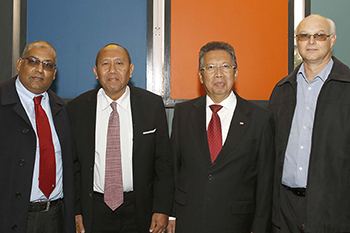
From the left were Prof Hussein Solomon, Senior Professor at the Department of Political Studies and Governance; Professor Ikrar Nusa Bhakti, Research Professor of the Indonesian Institute of Sciences; Suprapto Martosetomo, ambassador of the Embassy of Indonesia to South Africa; and Prof Theodor Neethling, Head of the Department of Political Studies and Governance.
Photo: Johan Roux |
“Indonesia and South Africa share one common trait which is diversity,” were the opening remarks of Suprapto Martosetomo, ambassador of the Embassy of Indonesia to South Africa. The ambassador drew parallels between the two republics at a public lecture hosted by the Department of Political Studies and Governance at the University of the Free State Bloemfontein Campus on 10 May 2016.
Professor Ikrar Nusa Bhakti, Research Professor in the Indonesian Institute of Sciences, presented the lecture on “Managing Political Diversities: The Indonesian Experience.” He outlined the history of Indonesia’s political and economic development, political system, and government’s policy in dealing with political and economic challenges, as well as the lessons learned from its experience.
Diversity and governance
As is South Africa, Indonesia is a ‘rainbow nation’. Being the largest country in the Southeast Asia, it boasts a population of approximately 250 million people, 300 ethnic groups, and 650 local languages. However, despite such diversity, the nation has been united behind the motto of “unity in diversity”, which was adopted when Indonesia proclaimed its independence in 1945.
Indonesia and SA also bear similarities in terms of a multiparty parliamentary system. Their current Joko Widodo and our Jacob Zuma administrations are governed by policies including anti-corruption, economic prosperity, equity and equality, quality education and healthcare, and maintenance of security.
International relations
The two countries have a long-standing relationship since 1955 when the Asia-Africa conference was held in Bandung, Indonesia. The conference represented solidarity against colonisation.
Prof Hussein Solomon, Senior Professor at the UFS Department of Political Studies and Governance, attributes Indonesia’s success as a product of education and leadership - something South Africa could learn from..“Indonesia like SA has been struggling with how to balance social diversity, democracy, and a political system. Despite this, they have managed to develop a functioning democracy and a vibrant economy. They are one of the top 20 economies in the world, and by the year 2035 will be in the top seven economies in the world, according to the Goldman Sachs, report,” he said.